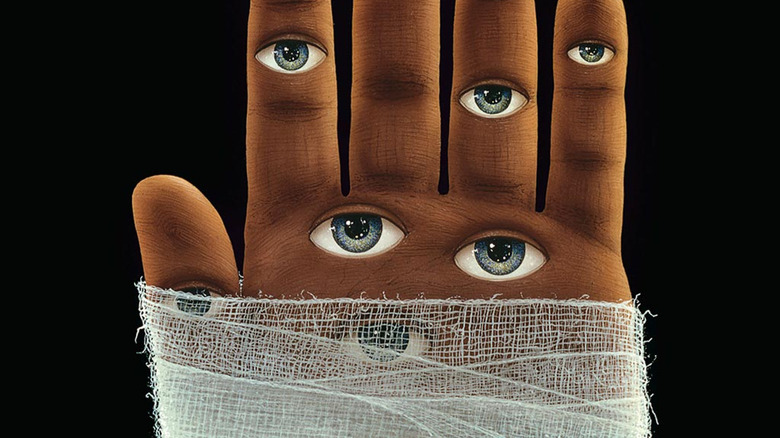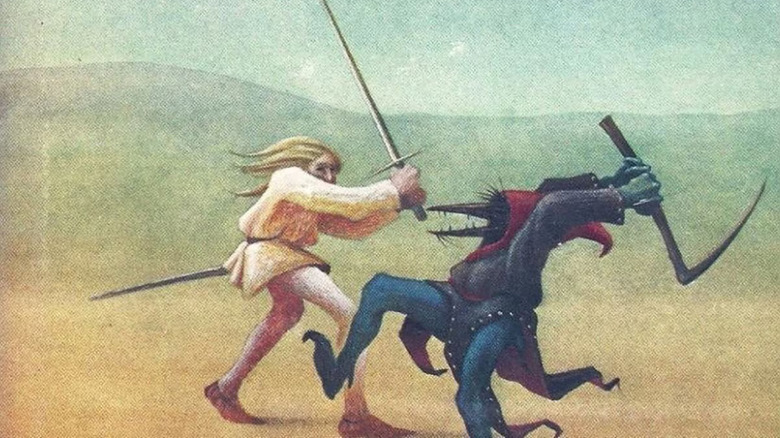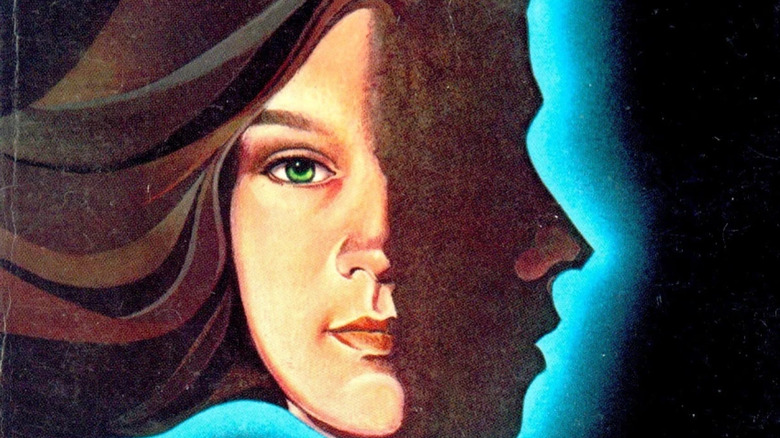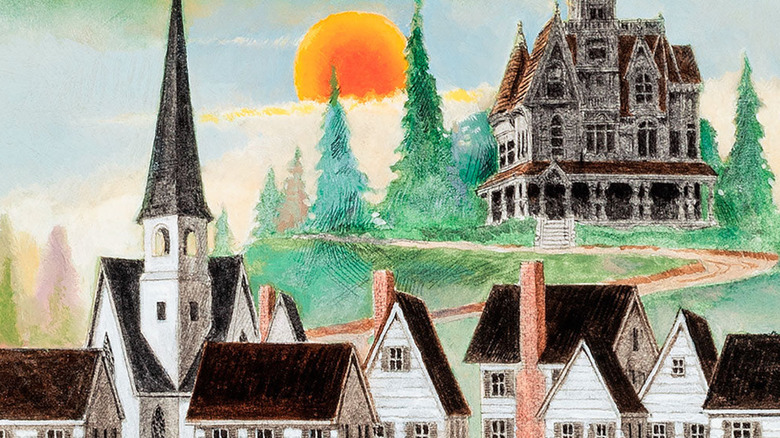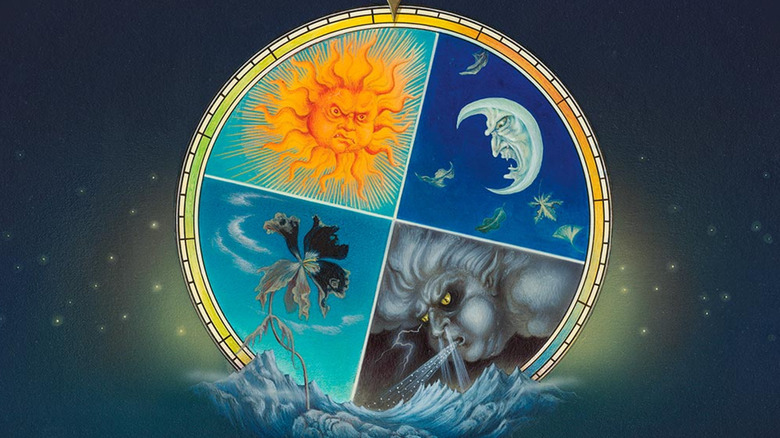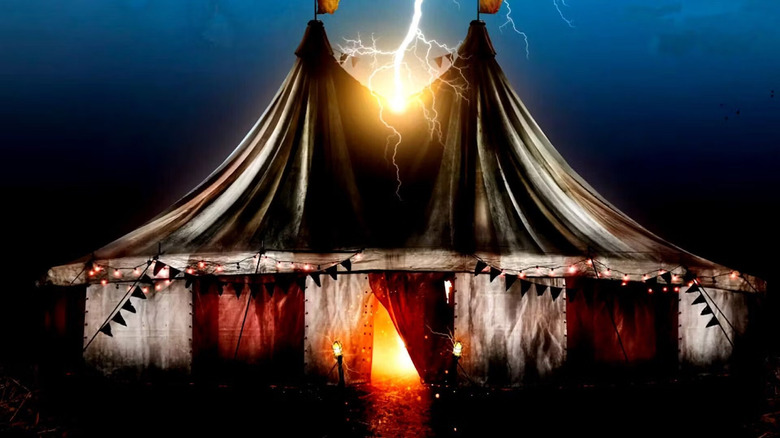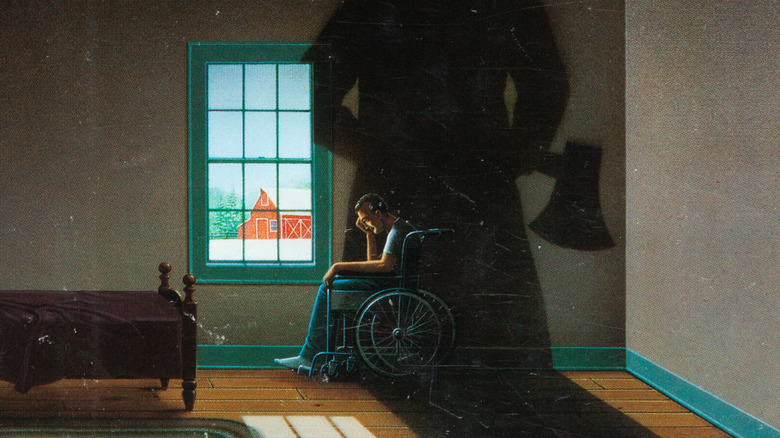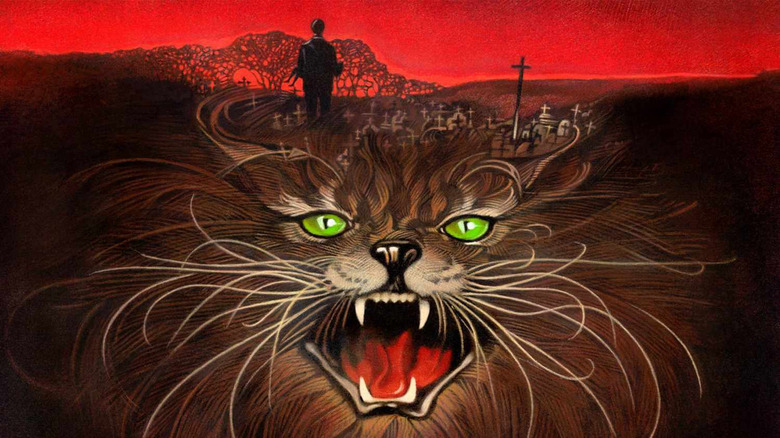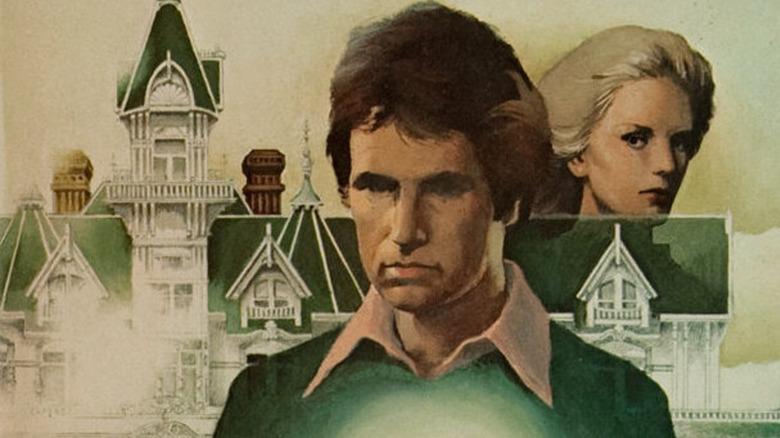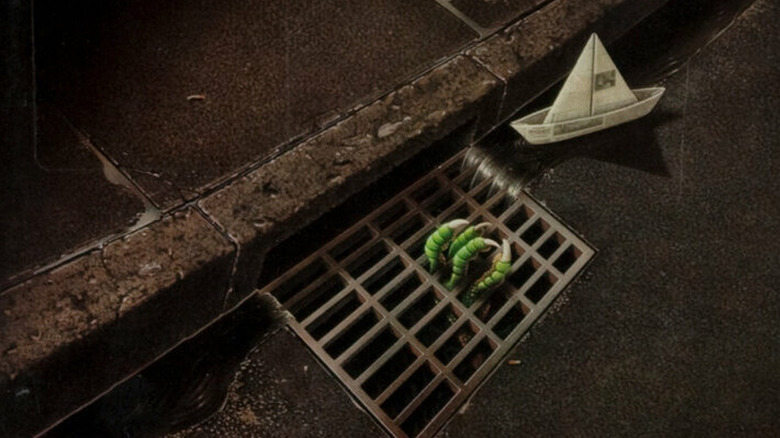The 10 Best Stephen King Books, Ranked
Stephen King has been scaring us for half a century, and he shows no signs of stopping. King has penned a lot of books, and fans will tell you there's value to be found in almost all of them. But what are the best of the best? That's a loaded question — everyone's tastes are different, and everyone has their own personal favorite King title. But we're going to take the leap and try to whittle it down to 10 books. Some of these choices might be controversial, but when considering King's entire body of work, we think these are the 10 best Stephen King books.
10. Night Shift
Stephen King has published a few short story collections (in fact, he just published on this year, titled "You Like it Darker"), but the King collection that had arguably the most impact was the first, "Night Shift," released in 1978. The common consensus in the world of publishing is that there's no money in short stories. Yet King had made such a name for himself by '78 that there was demand for more King! And before King hit it big with "Carrie," he had written a bunch of short stories, many of which ended up in men's magazines like "Cavalier." With "Night Shift," King compiled 20 stories and unleashed them on the public in one neat little package. These were bite-sized tales that delivered a dose of King to readers who might be too afraid to tackle his longer novels. As a result, a whole new batch of Stephen King fans were born.
The tales in "Night Shift" are pulpy and fun; simple stories about things that go bump in the night. King's strengths aren't exactly the ideas he comes up with, but rather how he handles them. He's immensely skilled at building characters and telling you everything you need to know about them in one or two sentences. This talent lends itself nicely to short stories, which need to hook you right away.
Within the pages of "Night Shift" reside "Children of the Corn," which is genuinely scary in story-form, despite what the endless terrible movies suggest; "Graveyard Shift," about blue-collar workers battling a giant rat monster; "Sometimes They Come Back," which is about malevolent greaser dudes, something King loves to write about; the unnerving "The Boogeyman," which features another familiar King trope: kids in peril; and more. Are all of these stories good? No, not entirely. "The Lawnmower Man," which inspired a movie that has pretty much nothing to do with its source material, is kind of ridiculous, although even there, King manages to invoke some unease. He's just that good.
9. The Stand
"The Stand" is the epic story of a guy with long hair and a sword fighting a bird-man wielding a pick-axe. Okay, that's not accurate, despite what the now-famous cover of the first addition might have you think. Instead, "The Stand" is one of Stephen King's biggest novels — a sprawling saga that runs on for over 1,000 pages in its uncut form. King has become known for writing very long books, and "The Stand" is among the longest. When it first hit shelves in 1978, King was required to cut it down to a little over 800 pages. However, in 1990, King got to publish the uncut 1,152-page version of the book, and this is the one most people are familiar with — especially since the tome experienced something of a revival at the height of the COVID-19 pandemic.
A classic tale of good vs. evil, "The Stand" is an apocalyptic novel about the end of the world and what comes after. When a superflu kills off about 99% of the world's population, the survivors slowly trek across the country and come together. King creates two distinct groups of survivors: the "good" group, who flock to an elderly woman named Mother Abagail, and the "bad" group, who are drawn to the supernatural Randall Flagg, a character who has popped up in several other King works, most notably the "Dark Tower" series.
"The Stand" deserves to be on this list because it's a major achievement, but it's also a bit messy. King doesn't outline his books — he merely sits down and goes where the story takes him. This occasionally leads him into trouble, as it did here. At one point, King realized the story was growing stale. His solution: killing off a huge chunk of his characters in an explosion. There are also seemingly endless chapters where the survivors hold painfully boring committee meetings as they attempt to rebuild society. But in the midst of all that is a "Lord of the Rings"-style saga that builds up a massive cast of characters and makes all of them seem unique and distinct. There are also scenes of unrelenting horror, such as when Larry Underwood, a rock star clearly modeled on Bruce Springsteen, has to shuffle his way through the pitch-black Lincoln Tunnel, which is choked with rotting corpses.
8. Carrie
In the 1970s, an English teacher named Stephen King was living in a trailer with his wife, Tabitha, and their two kids. When King wasn't teaching, he was sitting in the laundry room writing short stories. King primarily wrote stories about male characters, so when a friend challenged him to write a story about a female character for a change, he decided to give it a go. However, after pounding away at it, King gave up and chucked the story in the trash. Luckily, Tabitha fished it out and encouraged him to keep writing. And he did. The end result was not a short story, but a novel: "Carrie." The horror genre would never be the same.
Written partially in epistolary fashion — featuring newspaper excerpts and various other reports, much like Bram Stoker's "Dracula" — King begins "Carrie" by introducing loser teen girl Carrie White in an almost cruel fashion: "Carrie stood dumbly," he writes, adding a few sentences later: "She looked around bovinely. Her hair stuck to her cheeks in a curving helmet shape. There was a cluster of acne on one shoulder." It's easy to understand why all the other girls at school pick on Carrie and make her life a living hell. But King doesn't stay mean for long — eventually we get inside Carrie's head, and then we're sympathetic to this tormented girl who lives with her uber-religious mother and has no friends. And oh yeah, she also has telekinetic powers!
"Carrie" has become ingrained into our collective consciousness, so even if you've never read the book or seen Brian De Palma's movie (or the remakes), you know what happens: Carrie eventually goes to prom, gets a bucket of pig's blood dumped on her head, and then uses her powers to kill everyone. And I mean everyone: De Palma's movie ends with Carrie just destroying the prom, but in King's book, she obliterates the entire town.
There would be no Stephen King without "Carrie," so of course it has to make this list, although it's near the bottom because he would go on to write bigger and better things. King would become one of the biggest best-selling authors of all time as his career continued. And he owes it all to a poor, troubled teen named Carrie White. And "Carrie" endures to this day because its storyline of a badly tormented kid who eventually lashes out has sadly never gone out of fashion; it's more relevant than ever.
7. Salem's Lot
Sooner or later, every horror writer gives in to the urge to write about vampires. In 1976, Anne Rice would change the face of vampire fiction forever with "Interview With the Vampire," the work that pretty much popularized the concept of the "romantic" vampire in mainstream culture. But a year before that, Stephen King released his own tale of bloodsuckers with "Salem's Lot." While Rice's book took established vampire tropes and subverted them, King more or less just ripped-off "Dracula." King's idea was simple but kind of brilliant: what if Dracula showed up in the present day? Nowadays, we kind of take for granted the idea of gothic horror set in a present-day setting, but in 1975, this was a fresh idea (although, of course, Shirley Jackson got there long before King did).
So while "Salem's Lot" isn't entirely groundbreaking, it does deserve a place on this list for how much of an impact it had on vampire and horror fiction. It's also a really entertaining story, and it was the first King novel to use a writer as a protagonist, a concept he would return to again and again. Ben Mears moves back to his childhood hometown of Jerusalem's Lot to write a book about the Marsten House, a big gothic mansion that overlooks the town. The house has a dark and ominous history, but King really just uses it for atmosphere. The real threat to Salem's Lot isn't the house, but its new occupant: Kurt Barlow, an old-world vampire who pals around with his human familiar, the peculiar Richard Straker. Soon, Barlow is turning the townsfolk of the Lot into vampires, and Ben is teaming up with a ragtag group of vampire hunters to take them down.
"Dracula" isn't the only influence on "Salem's Lot." King is also drawing heavily on Grace Metalious' hit 1950s novel "Peyton Place," which was all about the dark side of a small town. King ultimately does a great job of painting the town in broad strokes, but he also clubs the reader over the head with overly purple prose that doesn't really sound like the Stephen King we all know and love. This was King's second novel, and it can therefore be assumed he was still trying to find his voice. Still, despite all these flaws, "Salem's Lot" is pulpy fun.
6. Different Seasons
Stephen King is so addicted to the craft of writing that he developed an interesting habit: he would write a novel, put it aside, and then immediately write a novella. In the afterword to "Different Seasons," a book comprised of four stories, King reveals: "Each one of these longish stories was written immediately after completing a novel — it's as if I've always finished the big job with just enough gas left in the tank to blow off one good-sized novella." King put these novellas in a drawer, primarily because they weren't really horror stories, and horror was what he had become known for. But by the 1980s, King was so big that he could pretty much slap his name on anything and get it on shelves, and that's exactly what he did.
"Different Seasons" was published in 1982, and by Stephen King standards, it was not a big hit. But three of the four stories here have since been adapted into movies, and two of those movies are arguably the best of the best when it comes to Stephen King films.
"Rita Hayworth and Shawshank Redemption" is a prison story of a man wrongfully convicted for murder. You no doubt have seen "The Shawshank Redemption," so you know how it turns out: he eventually tunnels his way to freedom. "Apt Pupil," the darkest story in the book, follows an all-American kid who turns out to be a budding psychopath. This boy's inherently evil nature is exploited when he discovers that a fugitive war criminal is hiding out in the sunny California town he calls home. The boy and the old man enter into an uneasy relationship that culminates in murder. "The Body," arguably the best story in the bunch, is like a warm-up for King's "It," telling a nostalgic story of a group of young friends who embark on a coming-of-age journey. The final story, "The Breathing Method," is a fun little story-within-a-story that ultimately ends in a gruesome but somewhat sweet fashion. It's odd that no one has turned it into a movie yet.
"Different Seasons" is perhaps the Stephen King book for people who don't like Stephen King books — it's a collection of stories that perfectly showcase King's writing prowess. Simply put, the dude can write. And with "Different Seasons," he conjures up four distinct tales that take the reader on a rollercoaster of emotions. The stories in "Different Seasons" are funny, touching, sweet, romantic, and, yes, scary. Each one lingers with you long after you've turned the page.
5. Revival
The common consensus is that while Stephen King was almost unstoppable in his glory days, his later work is lacking. But that's not accurate. While there are a few duds in King's modern-day output, he still manages to deliver something good or downright great from time to time. His JFK assassination/time travel tale "11/22/63," published in 2011, is excellent, as his is 2008 Florida ghost story "Duma Key." But the best of King's 21st-century work is "Revival," published in 2014. A mix of "Frankenstein" and Lovecraft, "Revival" is a slow-burning story that seems almost quaint at first, until it descends into a climax that's among the scariest things King has ever written. It'll have you jumping at shadows.
Spanning several decades, "Revival" follows Jamie Morton, who as a child befriends the young Methodist minister Charles Jacobs. Jacobs seems like the nicest guy on Earth, but when a horrible accident kills his wife and young son, this man of God goes off the deep-end and then vanishes. From there, King follows Jamie as he grows older and hits rock bottom. Jamie dreams of becoming a rock star. Instead, he develops a serious heroin addiction. From time to time, Jamie crosses paths with Jacobs, who pops up in odd places conducting vague experiments involving electricity.
Aside from a nightmare or two here and there (King, like most horror writers, loves nightmares), a huge chunk of the book is completely scare-free, which might throw some readers for a loop. But it's all part of the plan. As the author told Rolling Stone, "I wanted to make the story as warm as possible, because the best way to scare people is to really make the reader care about these characters." We grow to like Jamie and understand his struggles, and while Jacobs is a mostly detestable character, we're sympathetic to him because we know he suffered a great loss. All of this builds towards a finale that I won't dare spoil here, except to say the scariest thing about it is that it hints at a hopeless darkness that feels uncharacteristic for King. While he has a few novels that end on down notes, King is ultimately a big old softy, and he's fond of happy endings where good triumphs over evil. "Revival," however, suggests that we're all doomed to be damned in the end, no matter what we do.
4. Misery
By the 1980s, Stephen King was a superstar, and with that superstardom came superfans. Fans who expected — no, demanded certain things from him. So, when he published the fantasy novel "The Eyes of the Dragon" in 1984, some of those fans, who wanted nothing but horror from the best-selling author, were annoyed. Disgruntled fans weren't King's only problem; he was also grappling with addictions to drugs and booze, drinking entire cases of beer and snorting cocaine in his home office late at night as he pounded away at his keyboard. One night, while sleeping on a flight to London, King had a sweaty nightmare about a crazed fan keeping an author hostage. He thought it might make a good short story, and when he got to his hotel in London, he sat down at a desk once used by writer Rudyard Kipling and began to write, freehand, in a notebook.
The short story would eventually become a novel, and the novel was "Misery," published in 1987. While there's plenty of horror in "Misery," the book is a bit of a departure for King in that nothing supernatural occurs. Instead, all the horrific elements are based in the real world. Channeling both his obsessive fans and his own addictions, King spun a story about Paul Sheldon, an author who has struck it big writing romance novels about a heroine named Misery Chastain. But Paul is sick of Misery, and so he's killed his main character off and written a new crime novel. Unfortunately, Paul is about to have some serious bad luck: while driving through Colorado during a snowstorm, he crashes his car and is rescued by a nurse named Annie Wilkes. Annie claims she's Paul's number one fan, and she takes that role very seriously. Incensed that Paul would dare to stop writing Misery novels, Annie holds the writer captive in her secluded house, continually tortures him, and demands he write a new book that raises Misery from the dead.
"Misery" is a crackling psychological thriller that has King flexing his literary muscles and showing everyone he can write about more than sewer monsters and haunted houses. Annie Wilkes is one of King's best and most memorable creations, a walking nightmare inspired by both some of King's more obsessive fans and his own struggles with addiction. "Misery" is not your typical Stephen King novel, but it's definitely one of the most compelling (save for a few chapters where King publishes excerpts from Paul's crappy crime novel).
3. Pet Sematary
When "Pet Sematary" hit bookshelves in 1983, it had a great marketing gimmick: it was sold as the Stephen King book that was so scary it even scared Stephen King himself. While this claim was somewhat overblown, it had a basis in fact: after King wrote "Pet Sematary," he felt the subject matter was just too damn bleak to publish, so he put it away in a drawer. However, a messy contractual dispute with his old publisher Doubleday lead King to hand the manuscript over and essentially wash his hands of the thing. King's worries about the material turned out to be unfounded: "Pet Sematary" became a bestseller and one of the author's most popular novels.
It's also one of the best: a genuinely scary modern gothic soaked in dread. A story all about death and dying, "Pet Sematary" was inspired by real experiences King went through. In 1979, King moved his family to a house in Orrington, Maine, when he was offered a gig as the writer-in-residence at the University of Maine. The house happened to be next to a major road frequented by trucks, and one day, the King family cat Smucky was run over and killed in that very road. Smucky was buried in a crude pet cemetery deep in the woods near the house, and the entire experience got King's mind working. What would happen, the author wondered, if Smucky came back from the dead?
"Pet Sematary" uses this scenario and runs wild with it. When Louis Creed moves to Ludlow, Maine, to take a job as the campus doctor at the University of Maine, his life quickly goes from bad to worse. When the family cat, Church, is run over and killed, Louis' elderly neighbor Jud Crandall has a solution: burying Church in an ancient Native American burial ground deep in the woods. This patch of stony earth has the power to raise the dead — but the reanimated corpses come back different; changed in some unspeakable way. Church returns to life, but behaves oddly. But that's not the end of these grave shenanigans. Soon, Louis' toddler son Gage is also killed in the road, and despite dire warnings from Jud, Louis hatches a plan to bring his boy back to life.
King goes to extremely dark places with this book, and Louis Creed is one of the most damned characters he's ever created: a man who continually makes bad choices that result in terrible consequences. The inevitability of death, the one thing all living creatures have in common, is a scary enough concept on its own, and King exploits this for maximum effect.
2. The Shining
While "Carrie" introduced the world to Stephen King, "The Shining" is the book that solidified him as an almost unstoppable force. His first hardcover bestseller ("Carrie" didn't really start flying off the shelves until it hit paperback), "The Shining" is an elegant ghost story influenced by King's own alcoholism. King is sober now, but when he penned "The Shining," he struggled with drinking, and he poured all of that into the book. The Jack Torrence of the novel is a good man — a far cry from Jack Nicholson's instantly unlikable portrayal in Stanley Kubrick's famous film adaptation — who turns into a monster when he drinks. Jack's drinking has more or less destroyed his life and the lives of his family, and his last chance is to take a gig as a caretaker of the Overlook Hotel, a Colorado resort that shuts down in the winter.
Jack moves himself, his wife Wendy, and their child Danny into the hotel as the cold sets in, and things slowly fall apart because the Overlook is haunted — not just by ghosts, but by a kind of powerful evil force that draws on people's energy. Danny has a psychic ability that the Overlook wants to exploit, and it decides to use Jack and his addictions to get to Danny. King takes his time getting to all of this, though, instead spending huge chunks of the novel developing and exploring his characters and their tormented minds. "The Shining" is both scary and tragic, and it's the first King novel that really feels like the work of the Stephen King we all know. It's his third novel, and arguably the book where he really found his voice.
1. It
This is "It": the ultimate Stephen King book. A big, sprawling, epic horror extravaganza that more or less sums up everything Stephen King knows and has to say about horror. King kept writing long after "It" arrived in 1986, but it almost feels like a swan song; like the author is gathering up every single thing he's learned about scaring people and unleashing it in one giant package. (The book runs 1,138 pages.) Drawing on childhood nostalgia and monster movies, "It" pretty much invented the scary clown trope as we know it today. Sure, there were scary clowns before King's Pennywise, but every horror-influenced harlequin since is just ripping off King. A shape-shifting entity that feeds on fear, Pennywise is the ultimate King boogeyman.
But "It" isn't just about a scary clown. It's a story about friendship, about childhood, about life itself. It's a book for every lonely nerd who grew up pouring over scary stories and movies and feeling like an outcast. It's a book about love, about hate, about hope. It's the best thing Stephen King has ever done, flaws and all. (Yes, that infamous sewer scene is ill-advised, but it doesn't change the fact that the book is a monumental achievement.) Jumping back and forth in time like "The Godfather Part II," "It" follows a group of friends who grew up lonely and isolated ... until they found each other. They bonded over the fact that they were losers, the type of dweebs that were easy targets for bullies. And during the sweltering summer of 1958, these kids banded together to save the day and battle a monster. Now as adults, they have to return to their childhood hometown to stop the monster once and for all.
King pulls out all the stops here, pouring his heart out onto the page for all to see. Yes, there's plenty of horror here, but there's joy, too. The joy in growing up, in growing older, in watching the sun set. The joy in remembering that sometimes, magic is real.

